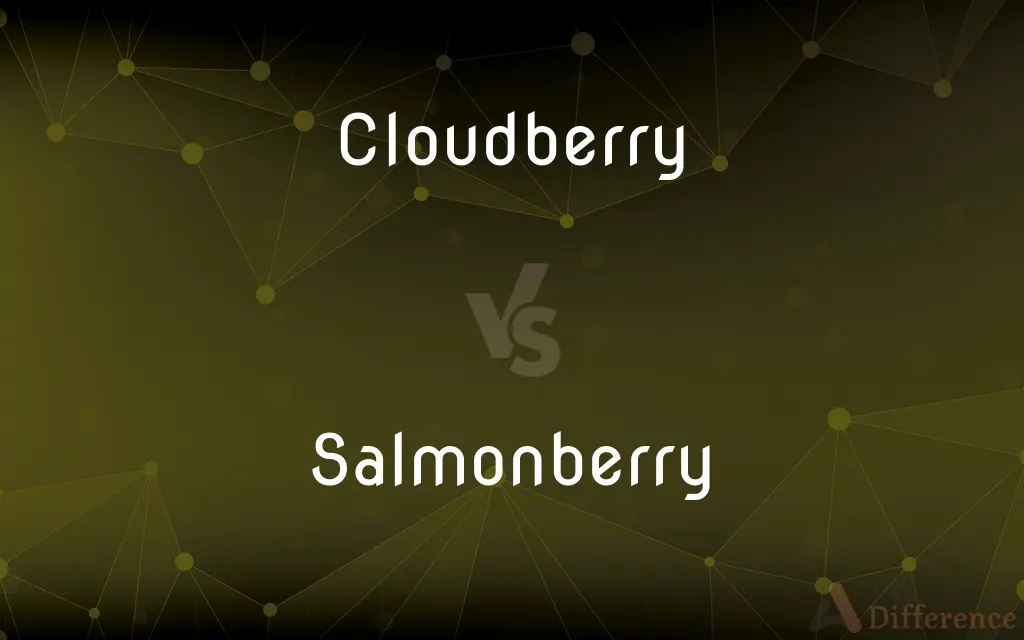Cloudberry vs. Salmonberry — What's the Difference?
By Tayyaba Rehman & Maham Liaqat — Updated on March 13, 2024
Cloudberries are rare, amber-colored fruits found in cool, boggy regions, prized for their unique taste and nutritional benefits, while salmonberries are common in the Pacific Northwest, known for their salmon-pink to orange color and mild, sweet flavor.

Difference Between Cloudberry and Salmonberry
Table of Contents
ADVERTISEMENT
Key Differences
Cloudberries (Rubus chamaemorus) grow in the wild, cold regions of the Northern Hemisphere, thriving in marshes and wetlands. They are highly valued for their rarity and unique, slightly tart flavor. Salmonberries (Rubus spectabilis), on the other hand, are found in moist forests and stream margins of the Pacific Northwest, offering a mild, sweet taste that varies from yellow to deep orange or red hues.
Nutritionally, cloudberries are rich in vitamin C and antioxidants, making them sought after for both culinary and medicinal purposes. They are often made into jams, desserts, and traditional liquors. Salmonberries, while also nutritious, are more commonly consumed fresh or in preserves, with a flavor that's less intense but enjoyable, contributing to local cuisine and foraging traditions.
The harvesting season for cloudberries is brief, occurring in late summer, which contributes to their exclusivity and high demand, especially in Nordic countries. Salmonberries have a longer picking season, from early spring to mid-summer, making them a more accessible fruit for local residents and wildlife.
Cloudberries have a distinctive, creamy texture and are often described as having a taste reminiscent of apricots and raspberries with a hint of floral. Salmonberries, with their softer, more watery consistency, are compared to raspberries but are less tart, offering a subtler flavor profile that pairs well with other berries.
Economically, cloudberries can command high prices, particularly in regions where they are considered a delicacy, such as Scandinavia. The market for salmonberries is more localized, with the berries often shared within communities rather than widely commercialized, reflecting their abundance and cultural significance in the Pacific Northwest.
ADVERTISEMENT
Comparison Chart
Habitat
Cold, boggy regions of the Northern Hemisphere
Moist forests, stream margins of the Pacific Northwest
Color
Amber to golden
Salmon-pink to orange
Taste
Unique, slightly tart, reminiscent of apricots
Mild, sweet, less intense
Nutritional Value
High in vitamin C and antioxidants
Nutritious but less researched
Usage
Jams, desserts, liquors
Fresh, preserves, local cuisine
Harvest Season
Brief, late summer
Longer, early spring to mid-summer
Texture
Creamy
Softer, more watery
Economic Value
High, considered a delicacy
More localized, shared within communities
Compare with Definitions
Cloudberry
Grows in marshes and wetlands, making it a sought-after berry during its short season.
We went cloudberry picking in the bog last August.
Salmonberry
A common berry in the Pacific Northwest, ranging from salmon-pink to orange in color.
The trail was lined with salmonberry bushes in full bloom.
Cloudberry
A rare, amber-colored fruit found in cool, northern regions, valued for its unique flavor.
The cloudberry jam was a special treat from her trip to Scandinavia.
Salmonberry
Found in moist forest areas, accessible for foraging.
We spotted salmonberries near the stream during our hike.
Cloudberry
Used in making traditional liquors and desserts in Nordic countries.
Cloudberry liqueur is a popular digestive in Norway.
Salmonberry
Offers a mild, sweet flavor, often eaten fresh or in preserves.
She made a batch of salmonberry jam from her backyard harvest.
Cloudberry
Symbolizes rarity and luxury in culinary contexts.
Cloudberries on the menu signify an upscale dining experience.
Salmonberry
While nutritious, it is less celebrated globally than cloudberry.
Although not as well-known as cloudberries, salmonberries have their own appeal.
Cloudberry
Known for its high vitamin C content, often used in traditional and gourmet dishes.
Cloudberries are a key ingredient in this luxury dessert.
Salmonberry
Integral to local cuisine and foraging traditions of the Pacific Northwest.
Salmonberry pie is a traditional springtime dessert here.
Cloudberry
A creeping perennial herb (Rubus chamaemorus) in the rose family, native to northern North America and Eurasia and having white flowers and edible yellowish fruit.
Salmonberry
A prickly shrub (Rubus spectabilis) of western North America, having trifoliolate leaves and fragrant pinkish or purple flowers.
Cloudberry
A species of slow-growing bramble, Rubus chamaemorus.
Salmonberry
The edible salmon-colored raspberrylike fruit of this plant.
Cloudberry
The fruit of these plants.
Salmonberry
A bush, Rubus spectabilis, found on the Pacific coast of North America.
Cloudberry
A species of raspberry (Rubus Chamæmerous) growing in the northern regions, and bearing edible, amber-colored fruit.
Salmonberry
The fruit from this bush, similar in appearance and texture to the blackberry and raspberry.
Cloudberry
Creeping raspberry of north temperate regions with yellow or orange berries
Salmonberry
Creeping raspberry of north temperate regions with yellow or orange berries
Salmonberry
White-flowered raspberry of western North America and northern Mexico with thimble-shaped orange berries
Salmonberry
Large erect red-flowered raspberry of western North America having large salmon-colored berries
Common Curiosities
Why are cloudberries so expensive?
Cloudberries are expensive due to their rarity, short harvest season, and labor-intensive collection process.
What are cloudberries?
Cloudberries are rare, northern berries known for their unique flavor and high nutritional value, often used in Nordic cuisine.
Can you eat cloudberries raw?
Yes, cloudberries can be eaten raw, but they are often made into jams, desserts, or liquors due to their tartness.
What makes cloudberries unique?
Cloudberries are unique for their rare occurrence, distinctive taste, and high content of vitamin C and antioxidants.
Is it safe to forage for salmonberries?
Yes, it's safe to forage for salmonberries, provided you correctly identify the berry and forage in a safe, permissible area.
Where can I find salmonberries?
Salmonberries are commonly found in the Pacific Northwest, in moist forests and along stream margins.
How do cloudberries grow?
Cloudberries grow in cold, boggy regions and are adapted to survive in harsh, northern climates.
Are salmonberries related to raspberries?
Yes, salmonberries are related to raspberries, belonging to the Rubus family, but they have a milder, sweeter flavor.
How long is the salmonberry season?
The salmonberry season lasts from early spring to mid-summer, depending on the local climate.
What dishes use salmonberries?
Salmonberries are used in fresh salads, jams, pies, and other local dishes in the Pacific Northwest.
Do cloudberries need a lot of sunlight?
Cloudberries grow in northern latitudes where sunlight is intense during the summer months, which is crucial for their development.
Can salmonberries be found outside the Pacific Northwest?
While salmonberries are primarily found in the Pacific Northwest, similar species or related berries may grow in other moist, temperate regions.
Are salmonberries good for you?
Salmonberries are nutritious, containing vitamins and minerals, although they are less studied than some other berries.
What is the best way to eat cloudberries?
Cloudberries are best enjoyed in jams, desserts, or as a luxury topping due to their rich flavor and creamy texture.
How do you preserve cloudberries?
Cloudberries can be preserved by making them into jam, freezing, or using them in liqueurs.
Share Your Discovery

Previous Comparison
Artillery vs. Cannon
Next Comparison
Malaria vs. TyphoidAuthor Spotlight
Written by
Tayyaba RehmanTayyaba Rehman is a distinguished writer, currently serving as a primary contributor to askdifference.com. As a researcher in semantics and etymology, Tayyaba's passion for the complexity of languages and their distinctions has found a perfect home on the platform. Tayyaba delves into the intricacies of language, distinguishing between commonly confused words and phrases, thereby providing clarity for readers worldwide.
Co-written by
Maham Liaqat













































